20 Best Corner Kitchen Sink Ideas for Your Home
Tucked into an overlooked corner, the kitchen sink can become a surprisingly powerful design feature—one that transforms cramped layouts into efficient, eye-catching workspaces. The corner kitchen sink isn’t just space-saving; it’s a style statement.
Designers and homeowners alike are embracing this layout for its ability to open up countertops, improve workflow, and create focal points in both small and large kitchens. Whether it’s framed by windows or paired with open shelves, the impact is visual and practical.
But choosing a corner sink isn’t just about making use of empty space. From cabinet shape and faucet placement to sink materials and depth, the design possibilities—and potential pitfalls—are worth thoughtful consideration.
1. Stainless Steel Corner Sink
A stainless steel corner sink is a sleek, modern solution that seamlessly blends durability with smart design. Its reflective surface enhances light, making compact kitchens feel more open while complementing a wide range of countertop materials and finishes.
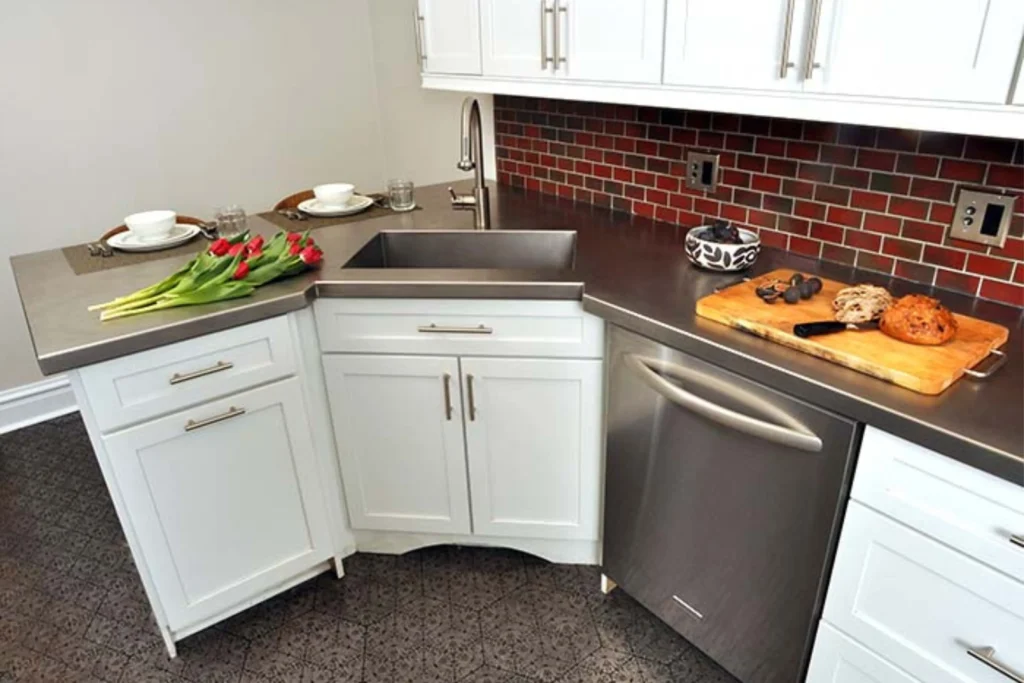
Beyond aesthetics, stainless steel offers practical benefits that stand up to daily use. It resists corrosion, is easy to clean, and can be molded into seamless designs that eliminate grime-catching edges. For busy households, it delivers both function and long-term performance.
2. Apron Front Corner Sink
An apron-front corner sink brings timeless farmhouse charm into a modern layout, offering both visual warmth and ergonomic design. Its forward-facing apron allows for easier access, reducing the need to lean over during long dishwashing sessions.
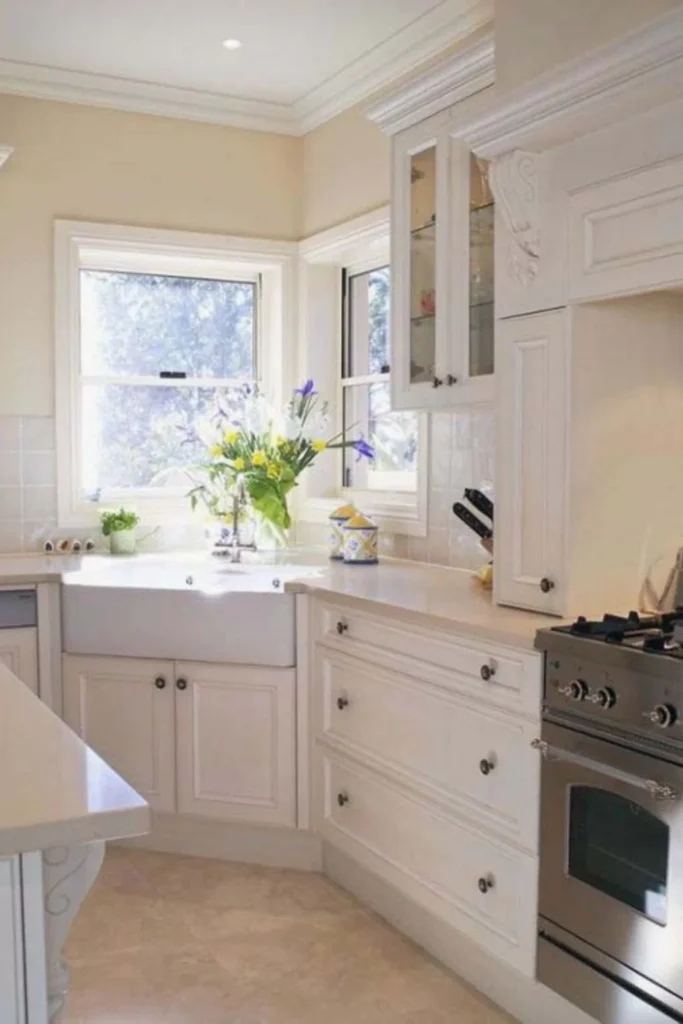
When positioned in a kitchen corner, this sink style creates a cozy focal point while preserving valuable counter space. Paired with natural light or rustic finishes, it adds character without compromising functionality—ideal for homeowners seeking a blend of comfort and clever design.
3. Double Basin Kitchen Sink
A double basin corner sink offers practical separation within a compact footprint, making multitasking in the kitchen much more efficient. One basin can handle food prep while the other manages cleanup, streamlining your workflow without sacrificing space.
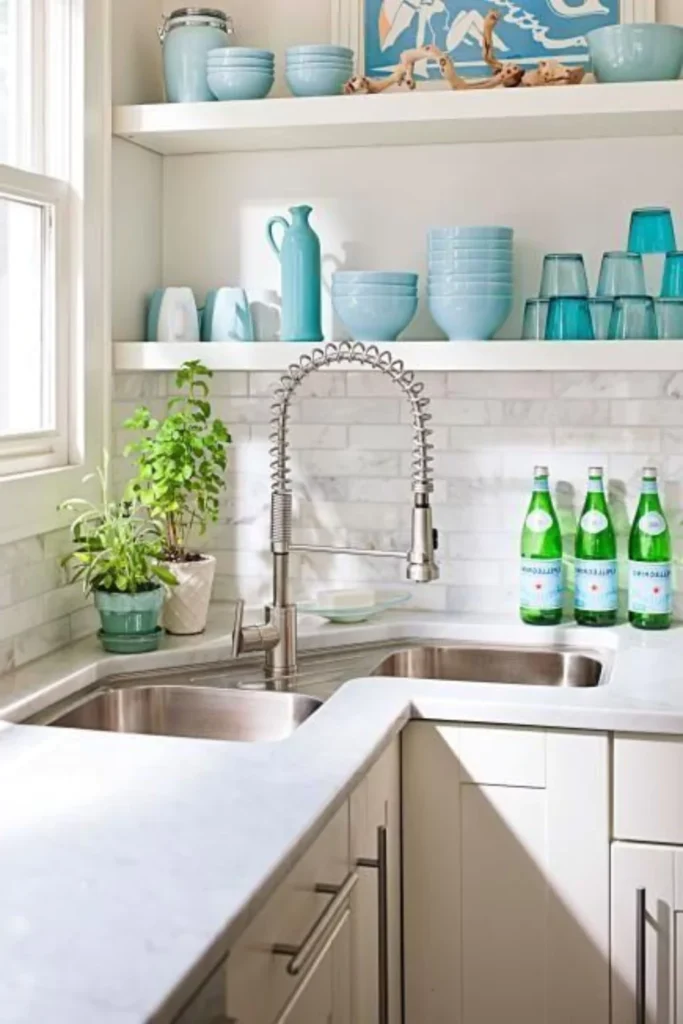
Its corner placement enhances movement between kitchen zones, especially in tight layouts. Whether you’re soaking pans or rinsing produce, the dual compartments provide flexibility, helping busy households stay organized and reducing the chaos of shared kitchen duties.
4. Corner Sink with a Window View
Positioning a corner sink beneath a window transforms a routine task into a peaceful pause. Natural light pours in, softening the space and creating a more inviting atmosphere for dishwashing, meal prep, or a quiet kitchen moment.
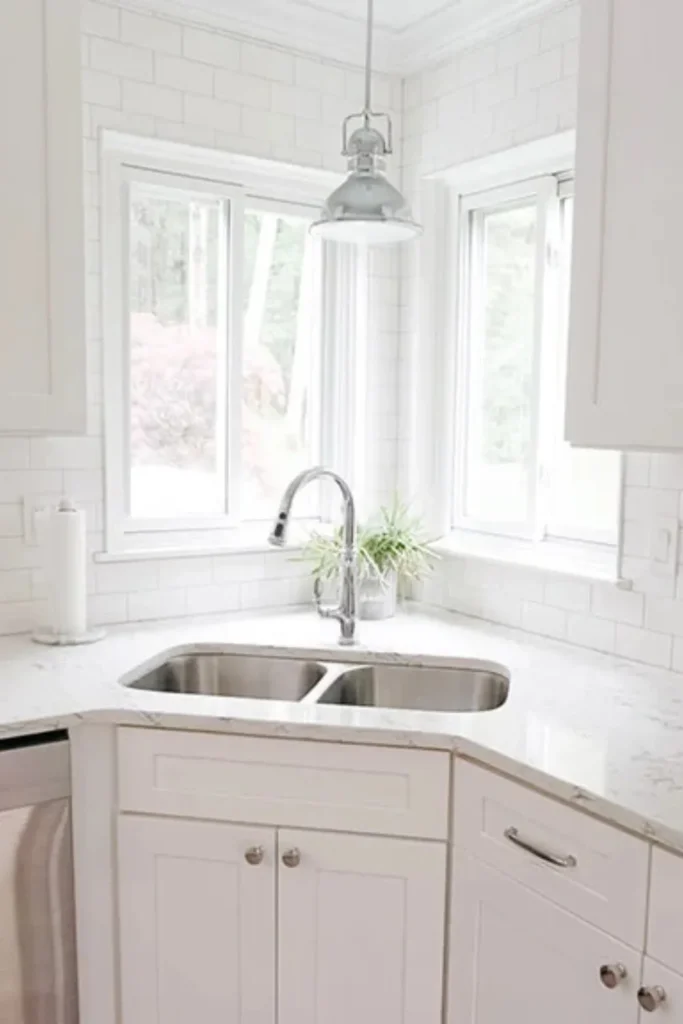
Beyond aesthetics, this layout maximizes functionality by combining an underused corner with a desirable view. It enhances ventilation, reduces reliance on artificial lighting, and subtly connects the kitchen to the outdoors—perfect for those who value both practicality and serenity in their design.
5. Compact Sink with Drainboard
A compact sink with a drainboard is a clever solution for kitchens where counter space is limited. It combines washing and drying zones in one streamlined unit, minimizing clutter while keeping essentials within easy reach during busy prep times.
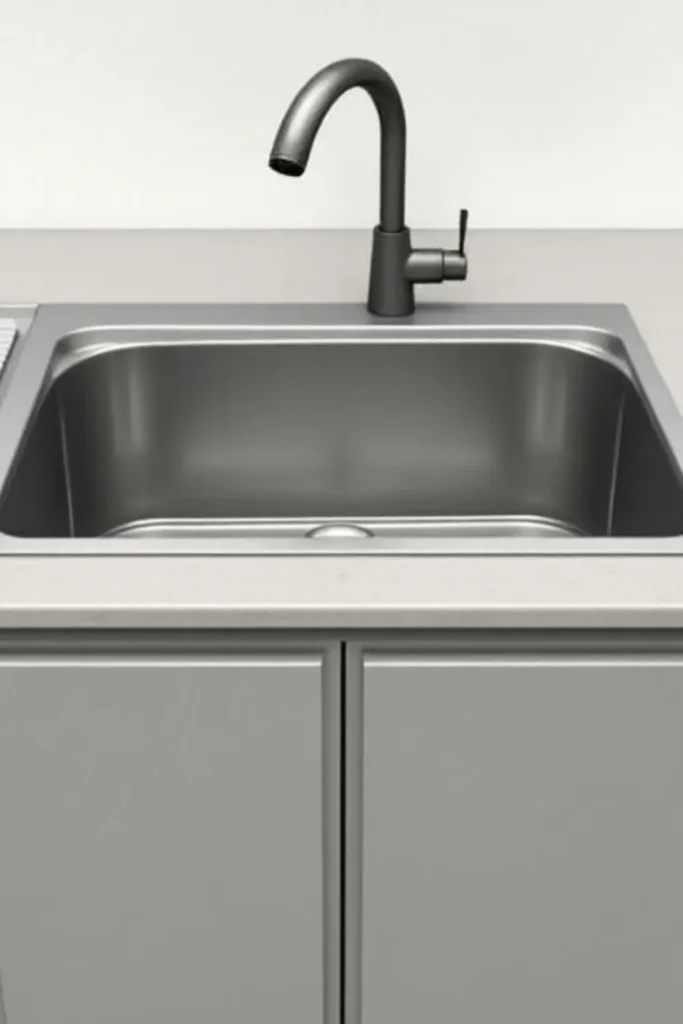
In a corner setup, the built-in drainboard utilizes awkward angles effectively, turning a once-unused area into a productive workspace. This design not only improves efficiency but also maintains a tidy look, perfect for minimalist or space-conscious kitchen designs.
6. Matte Black or Dark Finish Sink
A matte black or dark finish sink introduces bold sophistication to any kitchen corner, offering a striking contrast against light cabinetry or countertops. It’s a modern design choice that instantly elevates the overall aesthetic without overwhelming the space.
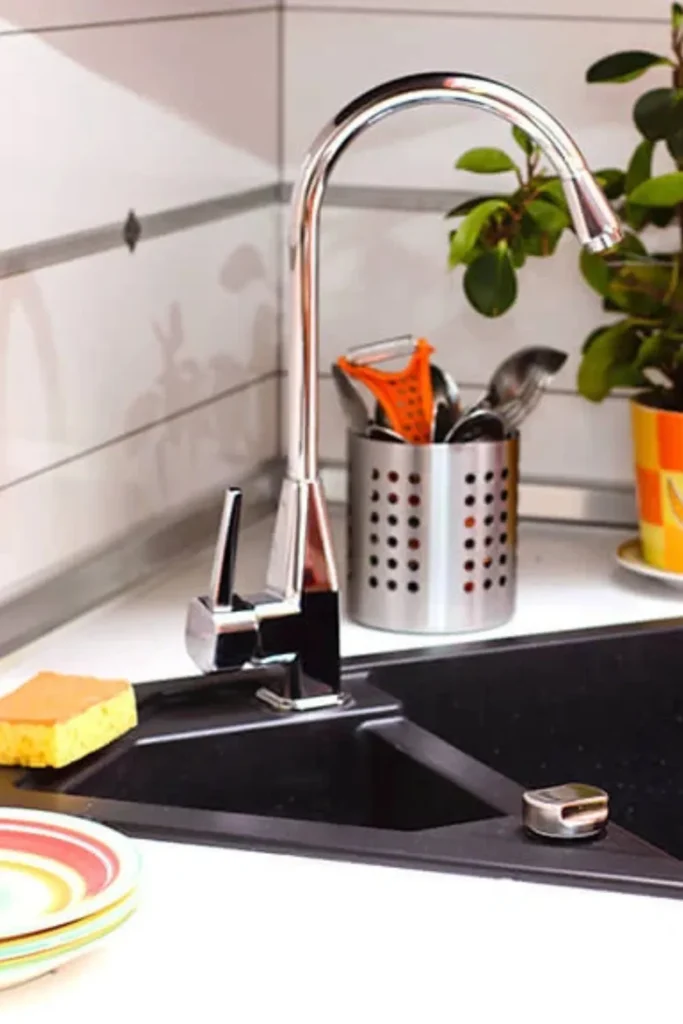
Beyond its visual appeal, a darker sink finish is practical for everyday use. It hides water spots and smudges better than lighter materials, making it ideal for busy households that value both function and low-maintenance style.
7. Hexagon Shaped Multifunctional Sink
A hexagon-shaped multifunctional sink is an innovative response to the challenges of corner placement. Its angular design fits neatly into tight spaces while offering multiple zones for rinsing, prepping, and draining—all within one cohesive footprint.
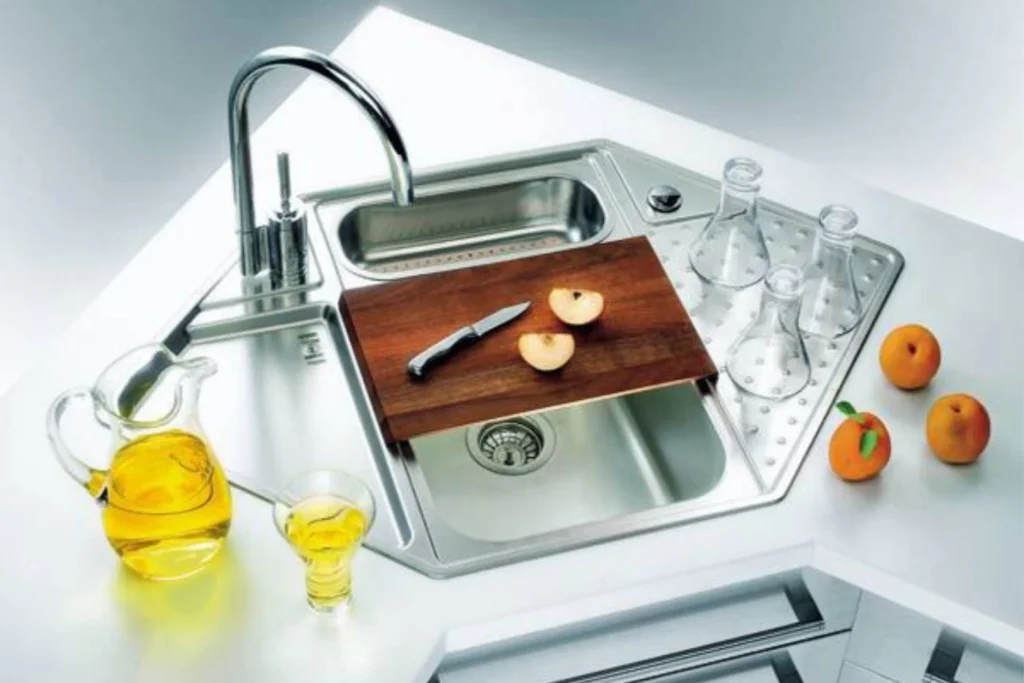
This sink style excels in efficiency without sacrificing visual interest. The geometric layout provides dedicated compartments that support a smoother cooking flow, especially in compact kitchens. It’s a thoughtful fusion of space-saving practicality and modern design versatility.
8. Undermount Corner Sink Design
An undermount corner sink delivers a clean, streamlined look by sitting beneath the countertop surface, allowing crumbs and spills to be wiped directly into the basin. This seamless edge enhances both hygiene and modern kitchen aesthetics.
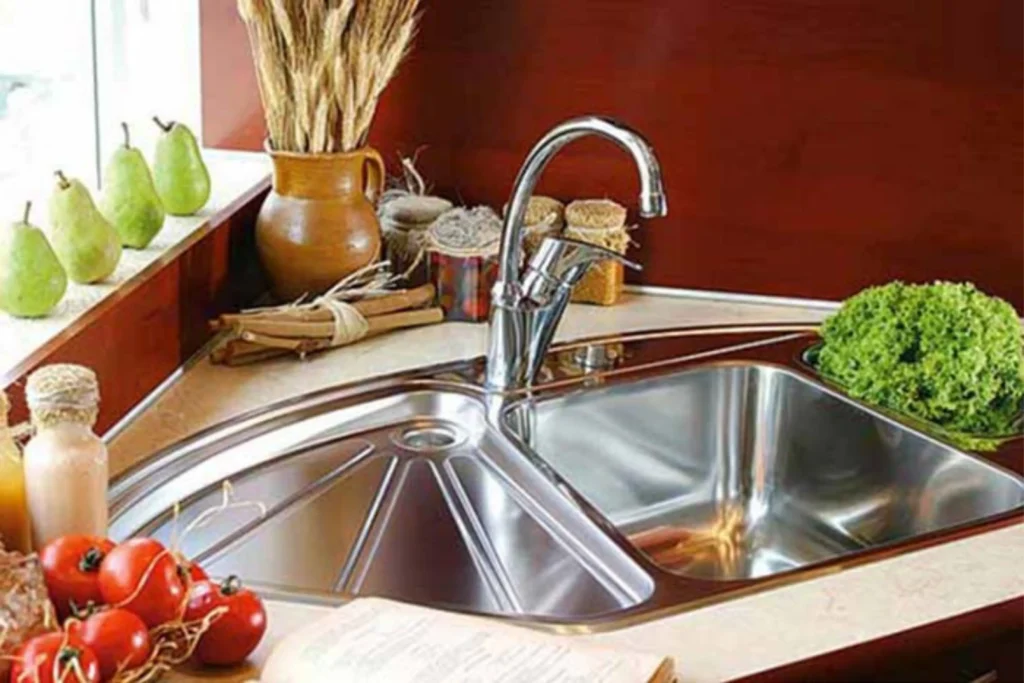
Its recessed installation also maximizes counter continuity, making tight kitchens feel more spacious and unified. In corner configurations, it blends practicality with visual simplicity, offering a clutter-free workspace that suits both minimalist and high-functioning kitchen designs.
9. Marble or Granite Countertop Corner Sink
Pairing a corner sink with a marble or granite countertop adds an instant sense of luxury and durability to your kitchen. These stone surfaces create a polished backdrop that highlights the sink while enhancing the room’s overall texture and depth.
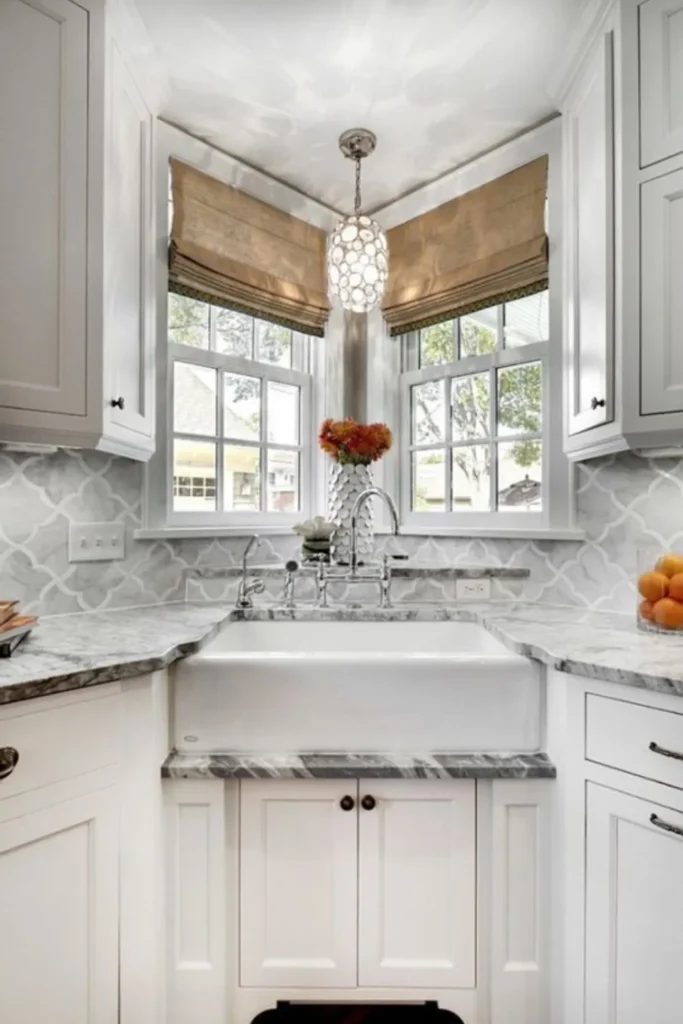
Beyond their visual appeal, marble and granite offer exceptional resistance to heat, moisture, and wear-making them ideal for wet zones like sink corners. The natural veining adds character, turning a functional nook into a beautifully integrated design feature.
10. Corner Sink with Open Shelf Storage
A corner sink paired with open shelf storage adds both style and function to your kitchen. The shelves provide easy access to frequently used items while visually opening up the space, especially in compact or U-shaped layouts.
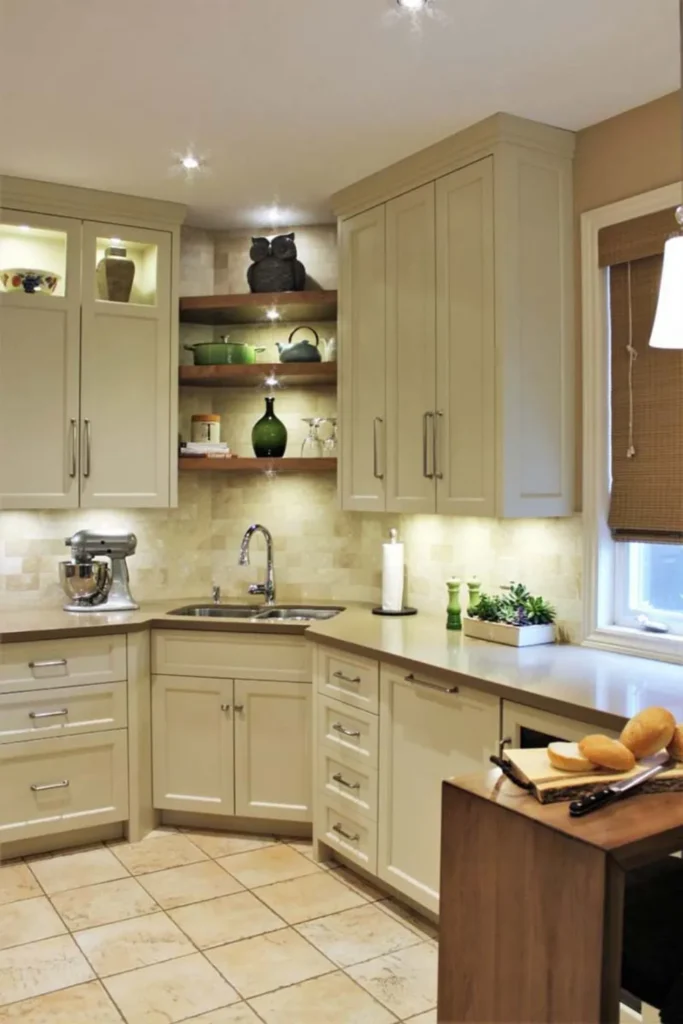
This design encourages intentional organization—perfect for displaying dishware, storing cooking essentials, or showcasing decorative pieces. It blends utility with charm, making the corner not just a workstation, but a personalized focal point in the heart of your kitchen.
11. Rounded Corner Sink Style
A rounded corner sink introduces soft curves into a space often defined by straight lines, creating a more fluid and inviting kitchen aesthetic. Its smooth edges also make cleaning easier, reducing grime buildup in hard-to-reach corners.
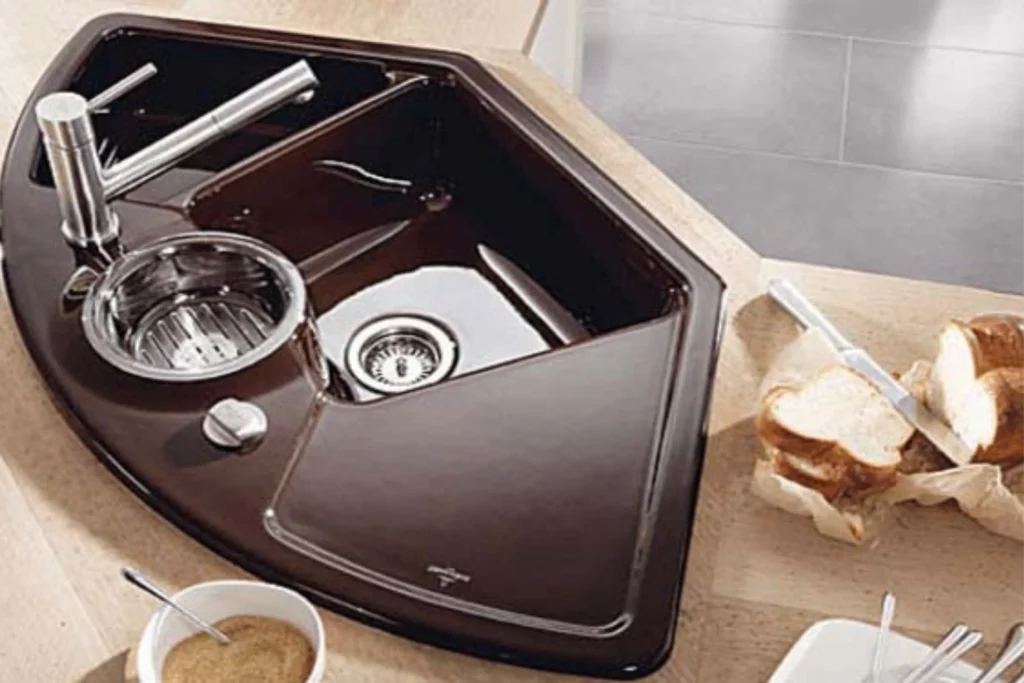
This style is especially effective in contemporary kitchens where organic shapes add warmth and balance. Whether paired with matte finishes or glossy countertops, a rounded sink offers a subtle yet distinct design choice that blends functionality with visual comfort.
12. Super Compact Corner Sink for Small Spaces
A super compact corner sink is a game-changer for kitchens where space is at a premium. Its scaled-down design tucks neatly into tight layouts, offering essential functionality without overwhelming valuable counter or walking space.
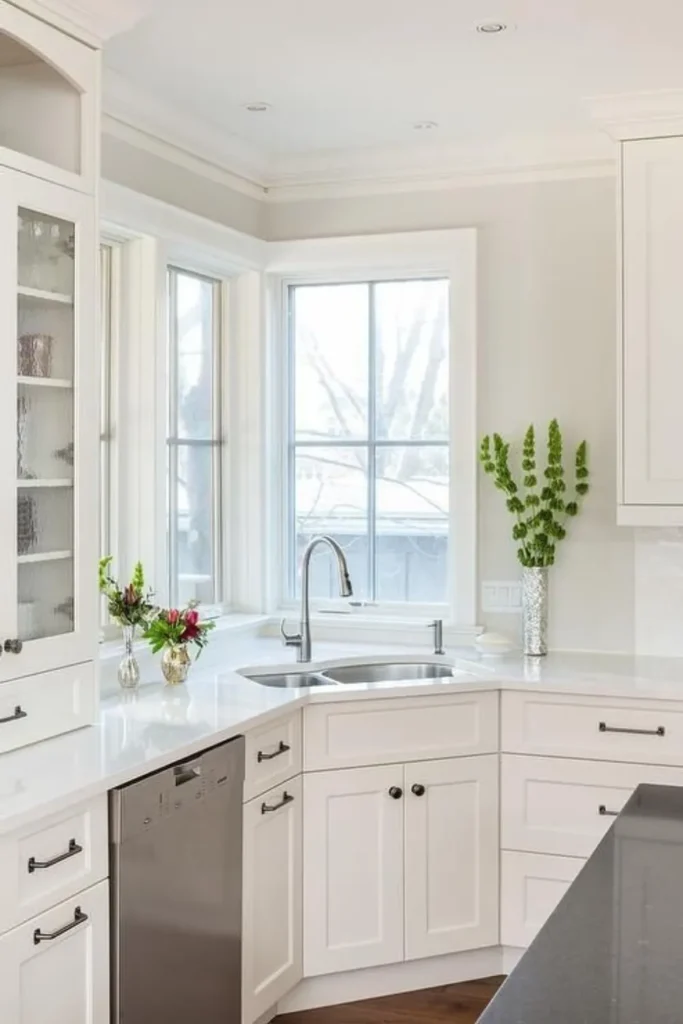
Despite its small size, this sink can handle daily tasks with ease, especially when paired with thoughtful accessories like a mini drainboard or built-in caddy. It’s a practical solution for minimalists, apartment dwellers, or anyone maximizing every square inch.
13. Modern Farmhouse Style Sink
A modern farmhouse style sink blends rustic charm with contemporary functionality, offering deep basins and clean lines that feel both classic and current. When placed in a corner, it brings cozy character to an otherwise overlooked space.
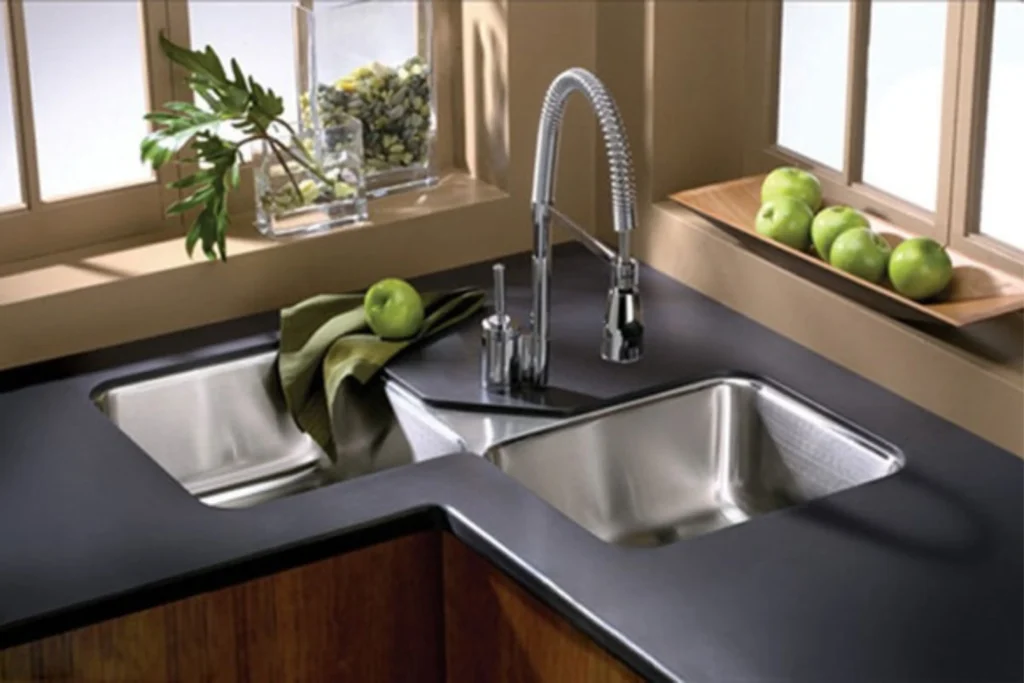
Often paired with shiplap walls, matte finishes, or vintage-inspired fixtures, this sink style becomes a warm focal point in the kitchen. It’s ideal for those who love the hominess of tradition but crave the efficiency of modern design.
14. Corner Sink with Kitchen Island Integration
Integrating a corner sink into a kitchen island is a clever way to enhance workflow in open-concept spaces. It anchors the workspace while encouraging interaction, making it easier to prep, clean, and socialize simultaneously.
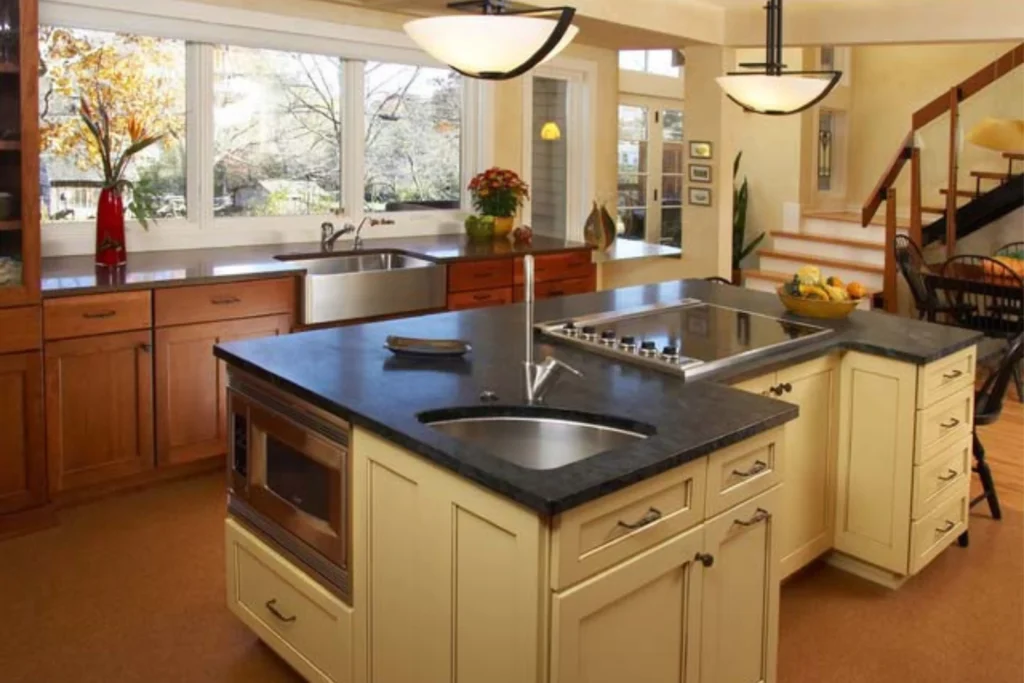
This layout works especially well in larger kitchens, where a second sink can support multitasking during big meals or gatherings. By utilizing the island’s corner, it maximizes surface area while keeping the central prep zone open and functional.
15. Traditional Kitchen Corner Sink Layout
A traditional corner sink layout embraces symmetry, classic cabinetry, and warm finishes to create a timeless kitchen environment. It often features paneled woodwork, polished hardware, and balanced proportions that complement the cozy charm of a more formal design style.
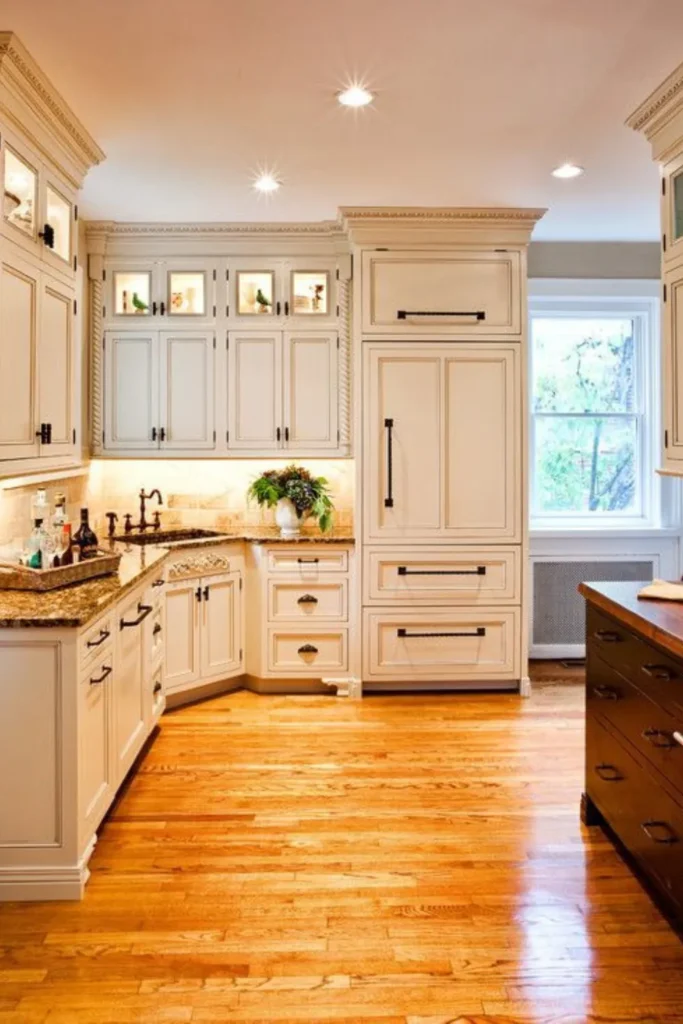
By placing the sink in the corner, the layout preserves long countertop runs on either side, ideal for baking, prepping, or serving. This setup caters to both functionality and visual harmony, making it a favorite in heritage-inspired kitchen spaces.
16. Wide Corner Sink for Larger Kitchens
A wide corner sink is ideal for spacious kitchens, offering ample room to wash oversized cookware without sacrificing surrounding counter space. Its generous proportions support multitasking, making it perfect for households that cook or entertain frequently.
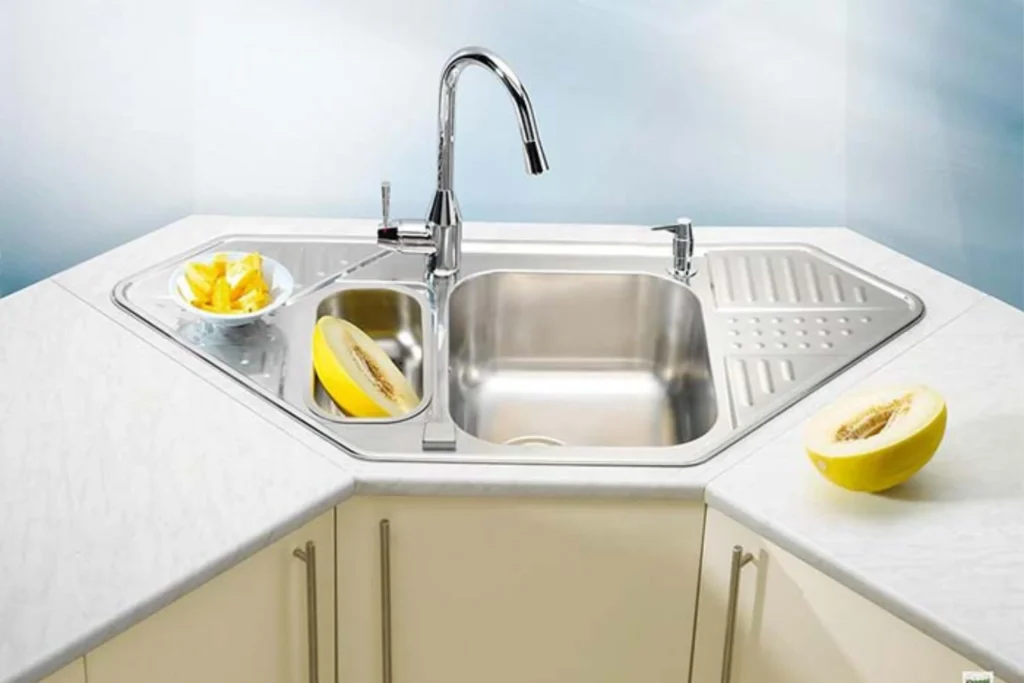
In larger layouts, this sink style also helps create designated zones for prep, cleanup, and plating. By utilizing a corner that might otherwise remain underused, it transforms function into a feature while maintaining the flow of a well-organized kitchen.
17. Corner Sink with Elevated Shelf or Backsplash
A corner sink with an elevated shelf or backsplash adds both utility and visual interest to an otherwise awkward space. The raised surface provides a convenient spot for storing soap, sponges, or decorative accents within easy reach.
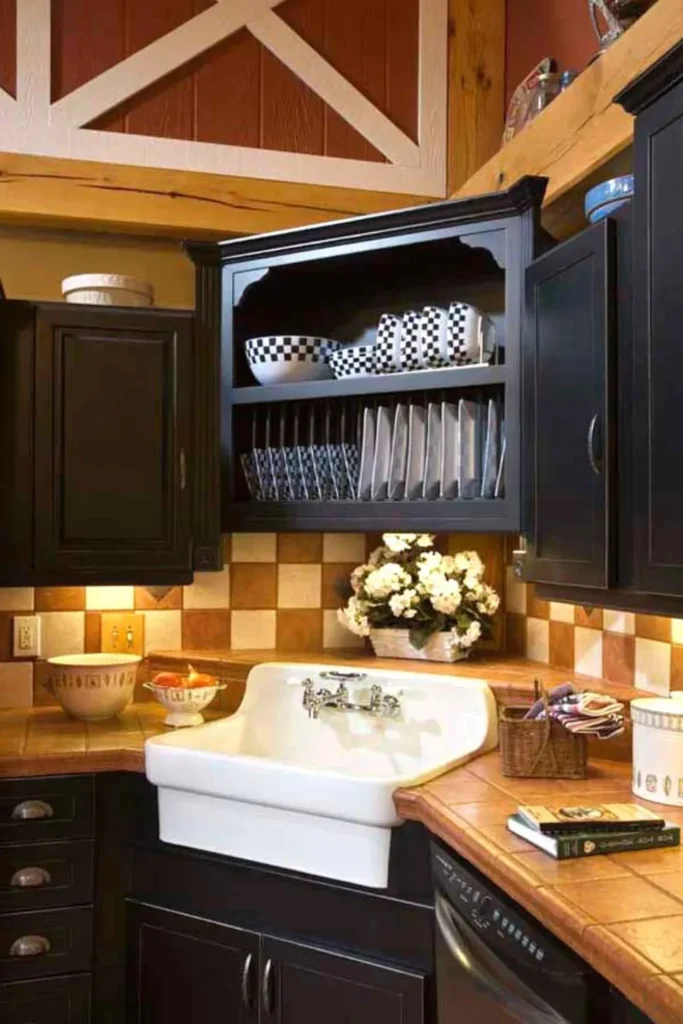
This thoughtful design detail also protects walls from splashes and water damage while enhancing the sink’s overall appearance. Whether minimalist or rustic, a well-designed backsplash or shelf brings organization and charm to your kitchen’s most frequently used corner.
18. Contemporary Sink with Extra Compartments
A contemporary sink with extra compartments is designed for efficiency, offering designated spaces for rinsing, soaking, or organizing utensils. This smart layout streamlines kitchen tasks, especially in busy households where multitasking is part of the daily routine.
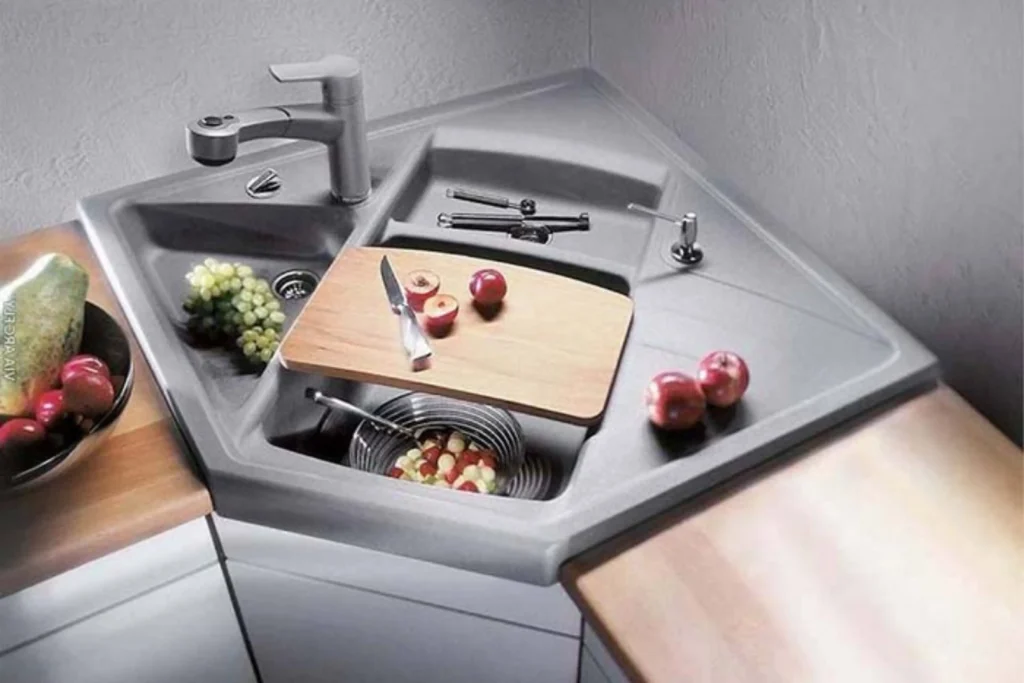
Beyond practicality, these sinks often feature sleek materials and clean lines that align with modern design aesthetics. The added compartments enhance functionality without cluttering the space, making them a perfect choice for homeowners who value both form and performance.
19. Diagonal Sink Cabinet Design
A diagonal sink cabinet design softens the hard angle of a kitchen corner, creating a more ergonomic and spacious workstation. Unlike sharp L-shaped setups, this layout allows for smoother movement and better access to surrounding countertops.
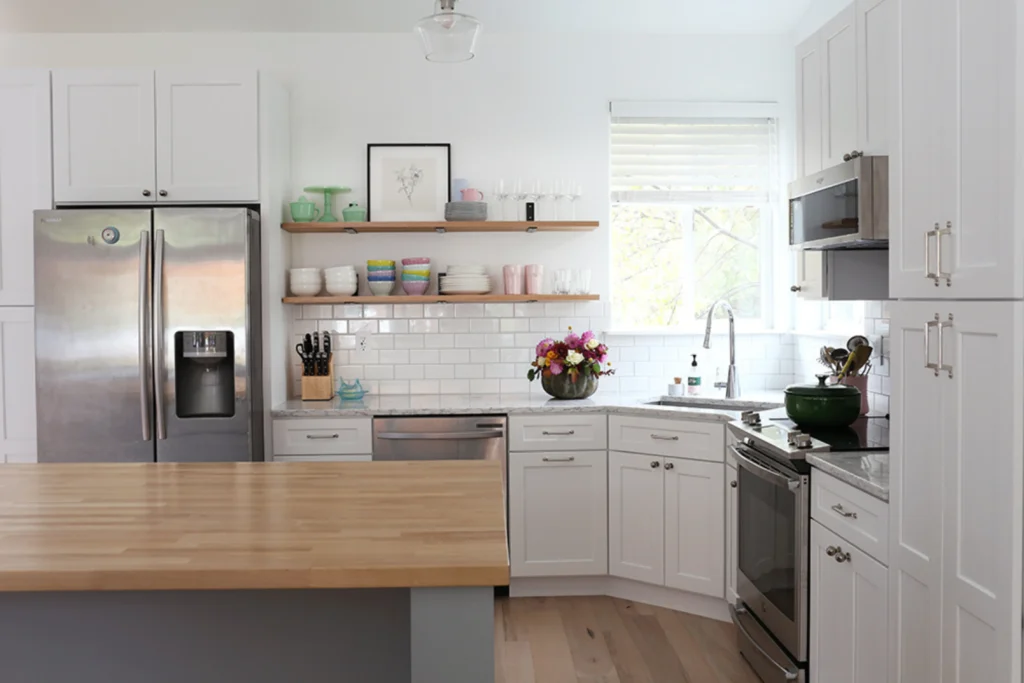
Visually, the diagonal orientation opens up the corner, making the kitchen feel less boxed-in. It also provides longer stretches of counter space on either side, which is especially valuable in smaller kitchens where uninterrupted surfaces are key to efficient cooking.
20. Efficient Corner Sink with Smart Faucet Placement
An efficient corner sink paired with smart faucet placement can drastically improve kitchen workflow. Positioning the faucet slightly forward or to the side enhances reachability, especially in deeper sinks or angled layouts that require more ergonomic access.
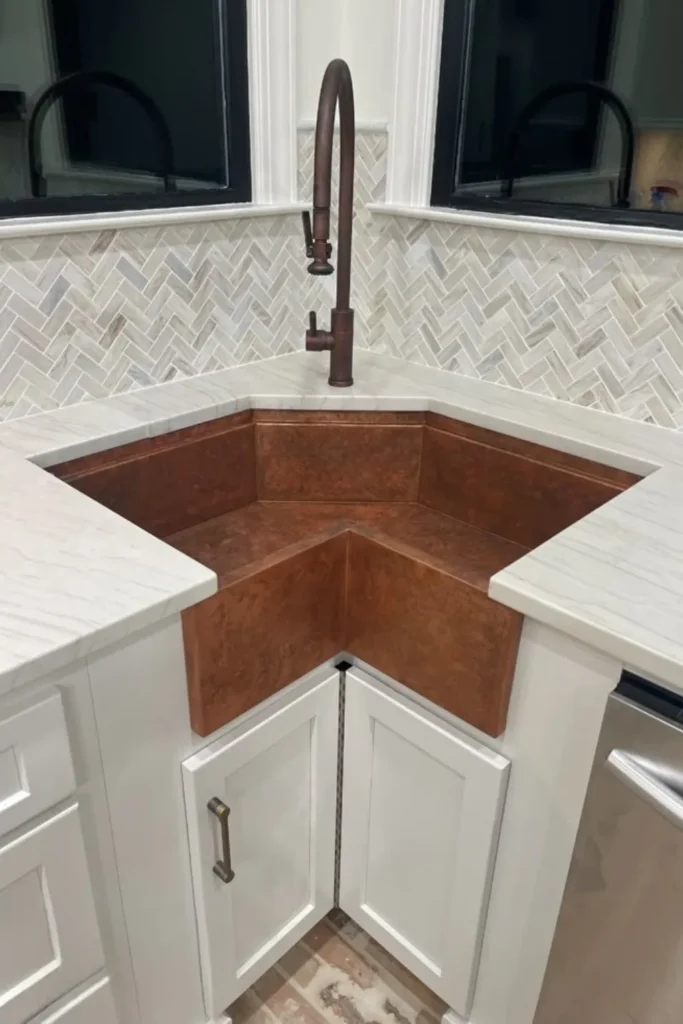
This thoughtful setup also reduces splashing and makes daily tasks like rinsing and filling pots more comfortable. When combined with pull-down sprayers or swivel features, the faucet becomes a multifunctional tool that adapts seamlessly to a compact corner environment.
For a more functional and stylish kitchen, don’t miss our favorite
Frequently Asked Question
What size sink fits best in a corner cabinet?
Most corner sink base cabinets are 36″ or 42″. The actual sink width should typically range between 24″ and 32″, depending on the mounting style and required setback for comfortable use.
Can I install a farmhouse sink in a corner?
Yes, farmhouse sinks can be installed in corners, but the cabinet must be designed accordingly. A diagonal or custom cabinet is usually required to support the weight and shape of an apron-front sink.
How do you style the space behind a corner kitchen sink?
Use the space behind the sink for low-maintenance plants, soap dispensers, or decorative trays. It’s a great spot to add personality while keeping essentials organized and within easy reach.
Conclusion
Choosing a corner kitchen sink is more than a space-saving decision—it’s a strategic design choice that blends function with personality. From sleek stainless steel to rustic farmhouse styles, the versatility of corner sinks allows homeowners to reimagine underutilized spaces without sacrificing beauty or efficiency. By thoughtfully considering layout, sink type, and practical features like faucet placement and storage, you can transform a once-forgotten corner into a dynamic centerpiece of your kitchen. Ultimately, the right corner sink not only enhances daily workflow but also reflects the character and rhythm of how you live, cook, and connect in your home.




